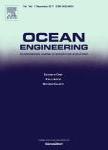版权所有:内蒙古大学图书馆 技术提供:维普资讯• 智图
内蒙古自治区呼和浩特市赛罕区大学西街235号 邮编: 010021

作者机构:Univ Queensland Sch Civil Engn St Lucia Qld 4072 Australia
出 版 物:《OCEAN ENGINEERING》 (海洋工程)
年 卷 期:2019年第172卷
页 面:407-421页
核心收录:
学科分类:07[理学] 0707[理学-海洋科学] 0824[工学-船舶与海洋工程] 0814[工学-土木工程]
主 题:Very large floating structure (VLFS) Wave energy converter (WEC) Hydroelastic response Connection design Multi-objective optimization Differential evolution (DE)
摘 要:This paper presents optimization of modular raft WEC-type attachment to VLFS and connections between floating modules of the VLFS for regular and irregular waves. The modular raft WEC-type attachment consists of multiple independent auxiliary pontoons connected to the fore edge of the VLFS with hinges and linear Power Take-Off (PTO) systems. The two objectives of the optimization are to maximize the reduction in hydroelastic response of VLFS and the power capture factor. The optimization process is proposed by using differential evolution (DE) algorithm. A numerical analysis framework based on finite element-boundary element (FE-BE) method is presented for determining the power capture factor as well as the hydroelastic response reduction for regular and irregular waves. The proposed optimization process is used to investigate the effects of the design variables, including PTO damping coefficient, pontoon length, the number of connections and connection stiffness, on the trade-off curve (i.e. Pareto front). In addition, the maximum power capture factor and hydro elastic response reduction are examined for various regular and irregular waves.